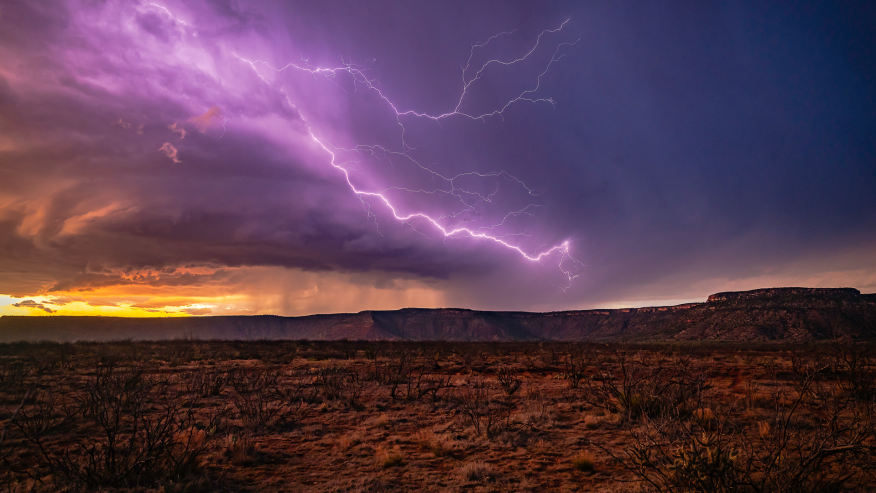
The New Mexico Monsoon
The majesty of the New Mexico Monsoon. Slow, deliberate, obstinate, discerning and generous. From the great deep of the equatorial Pacific it rolls into and across the vast deserts of Sonora and Chihuahua and tips its brimming cup onto the sun scorched mountains of the upper Rio Grande valley. The Sangre de Cristo. The life blood of New Mexico. Aqua es Vida. The moisture laden air mass moves with impunity from the south being pressed upward upon the Colorado Plateau. Wrung out upon the land, the arroyos fill, reservoirs and water tables are replenished. The acequia comes back to life after a long dreadful sleep, and native Blue Gramma grass will soon become green again, pushing up its short and proud stalks to form the ubiquitous sickle shaped seed top, both recognizable and easily overlooked. This year, looking down upon the seemingly barren soils of the Piñon Juniper forest that is Santa Fe’s home, it seems impossible that these low clumps of dry grass can actually be alive. Yet they are, and the monsoon rains now soaking the ground will prove that fact again.
The mega drought, as they call it, has been a few decades in the making. Lower than average rain and snow cumulating year upon year has left our soils desiccated, and the pinon tree susceptible to the bark beetle. It’s natural defense against the beetle is the production of its sticky sap, which engulfs and kills insect invaders as they try to burrow into the bark. In drought conditions the pinon is unable to produce sufficient sap to defend itself and the beetle population thrives. 2022 has seen another decline in the pinon population in and around Santa Fe.
People often ask, how will we continue to provide water to this growing community? A valid question. And it is heartening to know that Santa Fe is a world leader in water conservation, with one of the lowest per capita water use profiles in the U.S. We remain ahead of the curve in that regard. https://www.santafenm.gov/water_conservation
I recently re-listened to Woody Guthrie’s “Dust Bowl Blues”, a tribute to a previous mega drought from nearly a century ago. It is a first hand account of the severity and disregard nature can show to our needs, wants, and prayers. Caused in large part by the combined events of a massive scale up of till agriculture across the western plains and a 10 year drought, the dust bowl is recognized as one of the worst environmental disasters of our age. During this unusually dry and windy spring, I found myself wondering, will I be a dust bowl refuge? Thankfully, decades of soil conservation efforts, and improved water resource management has allowed the lands of the arid southwest to handle drought far better than we were able 100 years ago. And now with a record setting start to the 2022 New Mexico Monsoon, my nerves are again calmed, and I settle into the knowing that the rains do come.
Perhaps the greatest challenge facing the west in times of drought are wild fires. We have just seen New Mexico’s largest recorded wild fire. 2 fires, in fact, who merged to combust an area encompassing about 350,000 acres along the east side, the wet side as it were, of our Sangre de Cristo range. From the small town of Las Vegas, NM through Mora to the north up to Guadalupita nearly to Angel Fire. I fitting name. This blaze now known as the Calf Canyon/Hermits Peak fire sparked to life in early April. A season once still considered winter in the northern slopes of the Sangre de Cristo. A prescribed burn set with the good intention of reducing fire risks by the US Forest Service which quickly grew out of control. Having misread the signs, the lack of humidity, lack of stored moisture in the soils and canopy, the winds, it quickly became an inferno. What was once predictable in earlier years, now seems unpredictable. Simultaneously, in a nearby wilderness, an ember emerged from last year’s prescribed burn. A smoldering subterranean ember, having been resuscitated by the spring winds emerged upon the land to ignite those conifer forests in Calf Canyon and join its twin at Hermit’s Peak to form the largest burn recorded in our state.
Once underway, this blaze had only one remedy, despite the valiant efforts of firefighters on the ground and air tankers from above to contain its wrath. The mighty monsoon, which came on June 15 this year, the official beginning our our fifth and most beloved season. It came on time, not a day too soon, and has proceeded in its first couple weeks to drench our beloved landscape with life giving water.
Because of this generous start to the monsoon, the wild fires are now apparently under control and forest access restrictions are being lifted. The gardens and orchards will thrive this summer. The grasses will come back from their hibernation, and the magnificent display of wildflowers will bloom. The Piñon Juniper forest will be given its ration of life sustaining moisture in this years New Mexico Monsoon and perhaps the bark beetle will be thwarted for now . I sit and listen to the patter of a consistent rain on my roof, watching the runoff flow freely into the catch basins that convey it to the cistern that stores this precious resource. A full tank, that we will use to irrigate our greenhouse, gardens and landscape, we also use the rainwater caught in the cistern to flush toilets in our house, conserving water and re-using it to build soil, grow plants, sequestering carbon and moisture in the soil where life can thrive. https://palosantodesigns.com/green-building/



